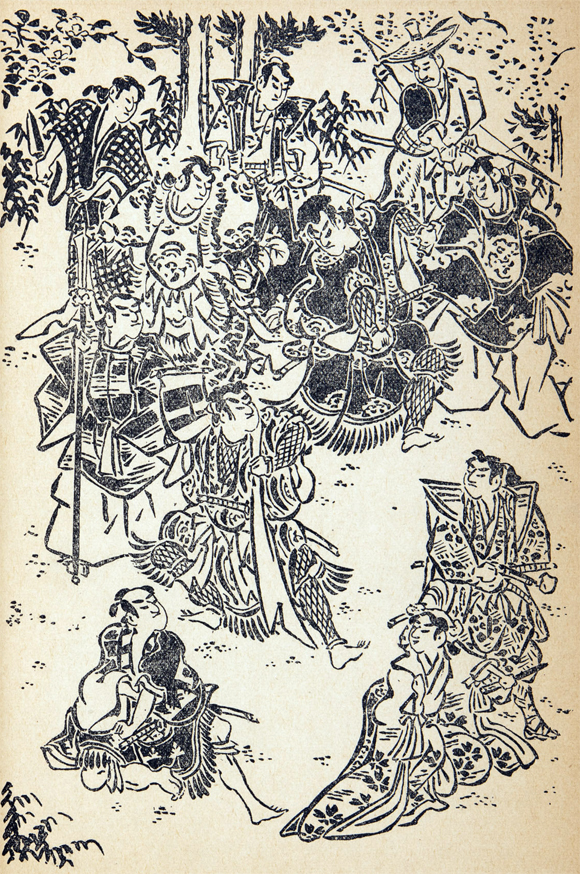| OTOWA-GA-DAKE DANMARI |
| Dance title | Otowa-ga-Dake Danmari |
||||||||||
| History |
The danmari "Otowa-ga-Dake Danmari" was premiered in March 1935 at the Kabukiza. It was staged within a special program which commemorated the 32nd anniversary (33rd memorial service) of the passing away of Onoe Kikugor˘ V and which celebrated the shűmei of Band˘ Shinsui VII [more details]. It was revived in 30 years later, in May 1965 at the Kabukiza, to commemorate the 16th anniversary (17th memorial service) of the passing away of Onoe Kikugor˘ VI and the shűmei of Onoe Kikunosuke IV, Onoe Tatsunosuke I and Band˘ Shinsui VIII. Some roles were changed in this revival:
Then, it was afterwards staged 4 times, always at the Kabukiza to celebrate an Otowaya related event:
|
||||||||||
| Key words |
Chichibu Danmari Gunpy˘ Hatakeyama Shigetada Kashin Keisei Kikori Kiso Yoshikata Otowaya Rikisha Ropp˘ Sanzoku Shiraby˘shi Shosagoto T˘zoku Tsujid˘ Yakko |
||||||||||
| Summary |
In the heart of the mountains [1], a band of samurai and their followers engage in a fierce battle against two larger-than-life thieves (sanzoku), Kumokiri Kesatar˘ and Otowa Yashagor˘ [2], vying for possession of the prized banner belonging to a samurai clan. A danmari, or "fight in the dark," ensues over the coveted treasure. Through dance-like movements, the characters skillfully mime their way through the darkness, with costumes and gestures revealing the distinct personalities of both the actors and their roles [3]. In a climactic moment, Yashagor˘ swiftly seizes the treasure, making a hasty exit. The remaining characters, with Kesatar˘ in a prominent stance, strikingly pose on the stage as the curtain descends. Following the closure, Yashagor˘ confidently exits on the hanamichi runway, displaying a triumphant and swaggering ropp˘ walk. |
||||||||||
| Notes |
[1] In the original 1935 dance-drama, the scene was set in Chichibu. [2] The two thieves spectacularly appear on stage from a tsujid˘. [3] Depending on the production, it might be the keisei Tsukuba, Hatakeyama Shigetada, the tsubone Tokiwagi, the yakko Datehei (in reality Kiso Yoshikata or not) or the yakko Tsumahei, Futaara no Iwagor˘, ďkubo Tomooki, Yűki Tamonnosuke, Edo Jir˘ Masayuki or Mitsumine Nuinosuke. The minor roles might be kashin, kikori, rikisha or gunpy˘. |
 |
|
Otowa-ga-Dake Danmari |
|
|
| Contact | Main | Top | Updates | Actors | Plays | Playwrights | Programs | Links | FAQ | Glossary | Chronology | Illustrations | Prints | Characters | Derivatives | Theaters | Coming soon | News |